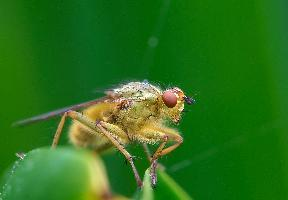
Popis zvířete
The Yellow Dung Fly, scientifically named Scathophaga stercoraria, is a fascinating creature that has captured the interest of both scientists and nature enthusiasts. This species belongs to the family Scathophagidae and is widely recognized for its striking yellow coloration, which can vary from a bright lemon hue to a more subdued golden, depending on environmental factors and the individual insect's age.Adult Yellow Dung Flies are robust and hairy, with females typically larger than males, reaching up to 10 millimeters in length. Their bodies are covered in dense, yellow to golden hairs, with the males often displaying a more vibrant coloration. This difference in appearance between the sexes is not just for show; it plays a crucial role in their mating rituals. The compound eyes of these flies are relatively large and provide them with excellent vision, a critical adaptation for locating mates and prey.
One of the most notable aspects of the Yellow Dung Fly's biology is its habitat preference. As its name suggests, this species is commonly found in association with the dung of large herbivores, such as cows and horses. The dung serves multiple purposes for these flies; it is a breeding ground, a feeding site, and a venue for mating. Females lay their eggs in or on the dung, where the larvae will find ample food upon hatching. The larvae, which are creamy white and maggot-like, feed voraciously on the dung, breaking it down and accelerating the decomposition process.
The Yellow Dung Fly is a diurnal predator, and while the larvae feed on dung, the adults have a more varied diet. Adult flies are known to prey on other insects, especially those attracted to the dung. This predatory behavior makes them important regulators of other insect populations within their ecosystem.
Mating behaviors among Yellow Dung Flies are highly competitive, especially among males. Males will often guard fresh dung piles, waiting for females to arrive. The most dominant males secure the best positions on these dung piles, where they have the first opportunity to mate with incoming females. This competition can lead to intense aerial battles and physical confrontations.
The Yellow Dung Fly's life cycle and behavior have made it an important model organism in ecological and evolutionary research. Scientists study these flies to understand more about mating systems, competition, and the role of insects in nutrient cycling within ecosystems. Their widespread presence across Europe and parts of Asia and North America, along with their adaptability to various environmental conditions, makes them a resilient and intriguing species.
In conclusion, the Yellow Dung Fly is more than just a fly on a dung heap. It is a creature of great ecological importance and scientific interest, with complex behaviors and a lifecycle closely intertwined with the environment. Its striking appearance, fascinating life habits, and the role it plays in the ecosystem make it a noteworthy subject of study and admiration.
Nové fotografie zvířat
Top 10 zvířat
- Chinese water dragon (Physignathus cocincinus)
- Galápagos tortoise (Geochelone nigra complex)
- Dolphin gull (Leucophaeus scoresbii)
- Japanese macaque (Macaca fuscata)
- Colombian red howler (Alouatta seniculus)
- Sea urchins (Echinoidea)
- Moustached guenon (Cercopithecus cephus)
- Diana monkey (Cercopithecus diana)
- Common reed warbler (Acrocephalus scirpaceus)
- Common house mosquito (Culex pipiens)